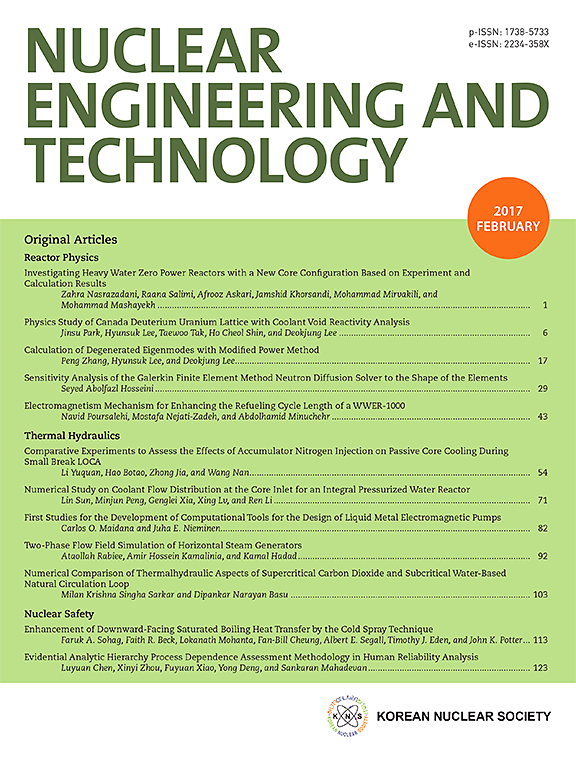电极配置对电解减速机电流密度分布的影响
IF 2.6
3区 工程技术
Q1 NUCLEAR SCIENCE & TECHNOLOGY
引用次数: 0
摘要
将轻水反应堆乏燃料回收为金属核燃料的热处理工艺涉及将氧化物转化为金属的电解还原过程。在当前电解还原研究的工程规模开发阶段,优化电解槽至关重要。本研究调查了实验室规模电解还原池开发中通常使用的传统防渗阳极护罩,以及旨在扩大电解还原池规模的平行多电极配置对电解还原池电流密度分布的影响。使用 COMSOL 建模对电流密度分布进行了分析。在恒定电池电压条件下,不使用防渗阳极护罩会导致总电流增加,并使电极上的电流密度分布变窄。此外,平行多电极配置也有效地增加了总电流,缩小了电极上的电流密度分布。这些结果表明,有必要使用可渗透阳极护罩和平行多电极配置来扩大电解减压器的规模。本文章由计算机程序翻译,如有差异,请以英文原文为准。
Effects of electrode configuration on the current density distribution of the electrolytic reducer
Pyroprocessing for the recycling of light water reactor spent fuel into metal nuclear fuel involves the electrolytic reduction process to convert oxides into metals. Optimization of the electrolytic cell is essential in the current engineering-scale development stage of electrolytic reduction research. This study investigates the effects of the conventional impermeable anode shroud, typically used in the development of laboratory-scale electrolytic reducers, and the effects of parallel multiple electrode configurations, aimed at the scale-up of the electrolytic reducer, on the current density distribution of the electrolytic reducer. The current density distribution was analyzed using COMSOL modeling. The exclusion of the impermeable anode shroud resulted in increased total currents under constant cell voltage conditions and contributed to the narrowing of the current density distribution on the electrodes. In addition, parallel multiple electrode configurations proved effective in increasing total currents and narrowing the current density distribution on the electrodes. These results emphasize the need to use a permeable anode shroud and a parallel multiple electrode configuration to scale-up the electrolytic reducer.
求助全文
通过发布文献求助,成功后即可免费获取论文全文。
去求助
来源期刊

Nuclear Engineering and Technology
工程技术-核科学技术
CiteScore
4.80
自引率
7.40%
发文量
431
审稿时长
3.5 months
期刊介绍:
Nuclear Engineering and Technology (NET), an international journal of the Korean Nuclear Society (KNS), publishes peer-reviewed papers on original research, ideas and developments in all areas of the field of nuclear science and technology. NET bimonthly publishes original articles, reviews, and technical notes. The journal is listed in the Science Citation Index Expanded (SCIE) of Thomson Reuters.
NET covers all fields for peaceful utilization of nuclear energy and radiation as follows:
1) Reactor Physics
2) Thermal Hydraulics
3) Nuclear Safety
4) Nuclear I&C
5) Nuclear Physics, Fusion, and Laser Technology
6) Nuclear Fuel Cycle and Radioactive Waste Management
7) Nuclear Fuel and Reactor Materials
8) Radiation Application
9) Radiation Protection
10) Nuclear Structural Analysis and Plant Management & Maintenance
11) Nuclear Policy, Economics, and Human Resource Development
 求助内容:
求助内容: 应助结果提醒方式:
应助结果提醒方式:


